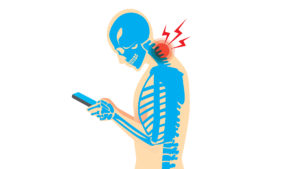
The next time you’re in a public place, look around.
Notice how many people are hunched over using mobile devices.
Poor posture while constantly looking down at a cell phone places a lot of strain on the neck, or cervical spine. It’s called ‘text neck.’
And, according to a recent reports, it can result in permanent harm.
“When the head is upright, the upper part of the spine is correctly aligned for minimal stress on the muscles, bones and discs in the neck,” explained Nuala Crotty, MD, a physical medicine and rehabilitation specialist with the Spectrum Health Medical Group. “But when you drop the chin to the chest for long periods, you increase stress on the cervical spine and strain the muscles at the back of your neck.”
Just how much wear and tear does this constant downward gaze put on the neck muscles?
The head weighs about 10 to 12 pounds. For every inch the head tilts forward, the weight or pressure on the cervical spine increases. Bending your head forward at a 60 degree angle, for example, results in almost 60 pounds of stress weight on a neck structure that’s designed to handle much less. That’s like carrying a small child around on your neck all day.
With smartphone users now spending an average of two to four hours a day with their heads dropped down, this results in 700 to 1,400 hours a year of excess wear and tear on the cervical spine, according to the research.
Over time, this much stress can do a lot of damage. Muscles and tissues become strained, sore and inflamed, causing headaches, neck, upper back, shoulder and arm pain.
According to Dr. Crotty, if left uncorrected, text neck can lead to chronic neck pain and an increased risk of disc herniation and neck arthritis. Poor posture also decreases lung volume, interfering with the ability to breathe deeply.
“The first step is to be aware of how you hold your body while using technology,” she said. “And then, take steps to prevent problems by practicing good posture and neck alignment.”
Dr. Crotty offers these tips to avoid feeling the crunch:
- Hold devices up, at eye level, as much as possible.
- Take regular breaks from phones and laptops throughout the day.
- Draw your shoulder blades together gently. This will naturally pull your head back and align your spine.
- Tuck in your chin and gently lengthen your neck. Imagine a string at the top or crown of your head, pulling it straight up to the ceiling.
- Roll or shrug your shoulders a few times and move your neck in different directions to prevent muscles from becoming tight.
See a doctor if neck pain does not go away or if it’s associated with pain, numbness, tingling or weakness in your shoulder, arm or hands.
 /a>
/a>
 /a>
/a>
 /a>
/a>